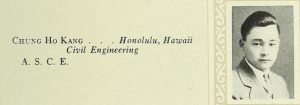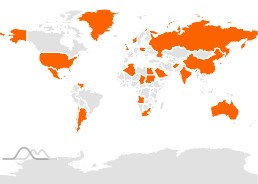Since at least 1915, Hawaiian students have been attending the University of Illinois. Early Hawaiian Illini have included accountants, aeronautical and astronautical engineers, architects, architectural engineers, bacteriologists, biologists, chemists, civil engineers, economists, electrical engineers, English majors, food technologists, historians, mathematicians, physical education majors, political scientists, sociologists, teachers, and zoologists too.
Read on to learn about early Hawaiian Illini!
For almost fifty years before Hawaii was admitted as a state on August 21, 1959, Hawaiian students were already coming to the University of Illinois for study. Many students were active members of multicultural organizations as well as honors societies in their fields of study. While many Illini have not donated student life records yet, nonetheless, some glimpses of Hawaiian Illini life can be found in student publications and student organization registration records. Below, multiple brief vignettes of Hawaiian student experiences are included.
Students
One of the earliest names among Hawaiian Illini is Mr. Alfred Amana (1915-1917) who was a frequently requested musician around town. Some of Mr. Amana’s guitar and ukelele performances included a Phi Gamma social party (1916), Mandolin Club (1916), national touring with The Bird of Paradise company (summer 1916), a local charity ball (1916), the Class of 1918 Sophomore Smoker (1916), a favorably reviewed Chinese Students Drama Club meeting (1917), the Champaign County Fair (1917), and a Chinese student organized October 10 celebration (1917). Locally, for academic year 1916-1917, Mr. Amana could be hired for performances or for guitar or ukelele tutoring too.
Mr. John Pang, (B.S. Civil Engineering, 1928), of Honolulu, was both an engineer and an intramural athlete. Daily Illini articles tell readers that Mr. Pang attended the 1927 and 1928 Engineering dances, as well as his senior year College of Engineering inspection trip (which featured inspections of engineering facilities in Chicago). He was also a pretty good tennis player, winning competitive intramural doubles matches in October 1927, October 1928, and November 1928.
Mr. Paul N. Morihara, (B.S. Architectural Engineering, 1931), of Honolulu, was an architectural engineer and a singer. During his undergraduate studies, Mr. Morihara participated in cultural events, like planning an international dinner at the off campus YMCA (1929), he played the ukelele at a Cosmo Club meeting (1929), he sang native Hawaiian songs at the Alpha Rho Chi Frosh Smoker (1929), and he sang at the first American Society of Civil Engineers chapter banquet (1930).
Some undergraduate students were able to remain in town to complete graduate degrees too. Mr. Wallace K. Kagawa (B.S. Architectural Engineering, 1943; M.S. Architectural Engineering, 1946), of Honolulu, completed both his bachelor’s and master’s degrees at Illinois. In 1940, with fellow Hawaiians Wilfred Fuchino and Clement Ching, he joined Cosmopolitan Club where he later became a student leader before distinguishing himself in his career. In Cosmo Club, he competed in a Club member rifle competition (1940), he attended a Midwest regional meeting (1940), he became Club librarian (1941), he had artwork featured in a traveling student art exhibit (1941). By the end of his undergraduate studies, he was honored for high grades in the College of Fine and Applied Arts (1943) and he was invited into the honorary and scholastic organization Gargoyle (1943). After graduation, Mr. Kagawa fought in World War II in the Anti-Tank Company of the 442nd Regimental Combat Team. [1] After the war, Mr. Kagawa returned to Illinois to complete a master’s degree.
During his graduate studies, Mr. Kagawa was elected vice-president of Cosmo Club (1946), he helped fund raise for the off-campus YMCA (1946), and he even earned a Beaux Arts Institute medal and Second Prize for his design of an Episcopalian Church (1947). After graduation, Mr. Kagawa worked in Detroit, Michigan before joining the architectural firm of Minoru Yamasaki–which helped design the World Trade Center in New York and the Jeddah Airport Pavilion in Saudi Arabia. In 1984, Mr. Kagawa and his wife retired in Hawaii.
Mr. Wilfred K. Fuchino (B.S. Architecture, 1943), of Honolulu, was another very active student. He joined the Cosmo Club in 1940 and the 1940 rifle competition too, In 1943, the Daily Illini interviewed Mr. Fuchino and other foreign students to get local foreign perspectives of how World War II was affecting other countries. In 1944, the DI wrote about the diversity of students in Architecture Design courses and again cited Mr. Fuchino. In 1944, he was honored with other students for high grade averages, he earned a Mention in the 1944 Beaux Arts Contest, he was on the student committee for the 1944 Illini Union and Cosmopolitan Club sponsored International Ball fundraiser for the Red Cross. In 1945, he was elected Cosmo Club librarian (and rumored by the Campus Scout newspaper column to be dating a woman named Janet), he graduated, and he was supportive of the new post World War security council.
During the 1950s, Hawaiian student enrollment increased and the first registered Hawaiian student organization would later appear. Nancy Chong Whitman (A.B. Physical Education 1954; A.M 1956; PhD 1961) was a scholar and a dancer. Shortly after transferring to Illinois from the University of Hawaii, in 1950, Ms. Chong joined the off campus YMCA. As part of positively reviewed “Shangrila” a student produced show about a fictional south seas cruise, Ms. Chong danced to four songs in a grass skirt at the Illini Union Club Commons (1950) and again with her Shangrila colleagues and the University Red Cross, Ms. Chong and others performed for the local Chanute Air Base too (1951). During her studies, Ms. Chong was found at many cultural events and some additional performances includes the International Fair (1951), an American Association for the Review of Contemporary Literature meeting (1951), and the Illini Union Club Commons (1951). Following these performances, Ms. Chong also played a leadership role in the establishment of the Hawaii Club.
Organizations
For the first few decades of Hawaiian Illini history, like Chinese Illini, Hong Kong Illini, Indonesian Illini, Malaysian Illini, Singaporean Illini, and Taiwanese Illini, some early Hawaiian Illini were part of the large historic Chinese Students Club. However, as early as the 1950s, some Hawaiian Illini and other interested students formed additional student organizations to explore the cultures of Hawaii too.
From 1953 until at least 1960, Hawaii Club was formed as a student organization open to all University community members interested in Hawaiian cultures. Some Hawaii Club events included new student mixers and dances (1955, 1956 ), homecoming parties (1955), socials (1956, 1957), off campus picnics (1957), flower sales for scholarship fundraising (1958), luaus (1958), and avid competitors in intramural basketball and softball too (1953-1959).
The first Hawaiian Night might have been in 1951, featuring dancing by Ms. Chong, singing by other Hawaiian students, a film about the islands, and a Hawaiian dinner too. The tables were even decorated with a variety of flowers which guests could take home. (Unfortunately, the silk leis worn by Ms. Chong were mistakenly taken home too.) Fortunately, many later Hawaiian Nights would come and this annual campus tradition continued throughout the 1950s. By the end of the decade, Ms. Chong would graduate and Hawaii became a U.S. state. Although the first decade of Hawaii Club was led by Ms. Chong, later Hawaiian Illini would continue the club over time up until the present.
For over one century, Hawaiian students have been coming to the University of Illinois to continue their studies. From education to engineering and from accounting to zoology, Hawaiian Illini have been coming from different cultural backgrounds and distinguishing themselves in different fields of study.
Are you a Hawaiian Illini? Do you know someone who is? We’d like to hear from you! Please send us a message or leave a comment below. We want to include you and your story, as we celebrate the first 150 years of the University of Illinois.
Happy First 150 everyone!
References
[1] “Wallace Kenso Kagawa“, Honolulu Star, January 11, 2015. For Mr. Kagawa’s account of his military service, please see: “Memories of August 15, 1944”, 517th Parachute Regimental Combat Team, Paducah, Kentucky: Turner Publishing Company. 63-66.


























